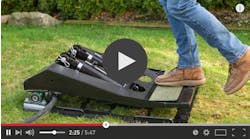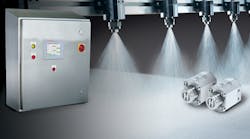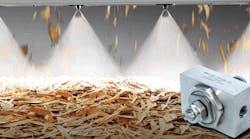If it squirts, it works.
For decades, this was the mantra guiding proper operation of industrial spray equipment.
The idea was as crude as the phrase itself.
It meant, basically, that if whatever you're spraying—be it lubrication, oil, chocolate, adhesive, or water—was depositing material on your product in some discernible way, then you could assume it was doing its job.
It gave no room to account for exact amounts or, really, any precision in application. The point was to get the stuff on the product. The more you could add, the better.
"A little bit of extra ingredients or lubricant or water applied back in those days wasn't a big deal," explains Patrick Tarantino, a design and controls engineer for Spraying Systems Co.
This was an understandable position back then, back when manufacturing was booming and waste was less critical, back before machines were smart and connected to optimize every minute step.
But times have changed.
"As manufacturing continues to improve and competition continues to increase, everything has to be under a microscope," Tarantino says. "That includes spraying equipment."
The problem, however, is that many companies still haven't yet woken up to this idea, and therefore have left their spraying systems back in the dark "if it squirts, it works" days.
"We still have many customers coming to us from systems that aren't controlled or precise—systems that require them to make some kind of estimation of their set points or target values for spray applications," explains Tarantino. "But you can't optimize anything or even think about optimizing anything if you don't have any idea what your targets should or could be."
And this, honestly, is shocking news in 2016. Operating blindly with no insight into your process? That just not how 21st century manufacturing works.
A Case for Smarter Spraying
As our ongoing series on the topic demonstrates, spraying equipment has been a very neglected area in this age of smart manufacturing.
Today, despite the availability of truly smart, precision machines, companies are still buying their $25 nozzles and throwing them on a line to slather their product, the belt, and the entire plant with materials, and assume it's all just fine.
That kind of thinking runs absolutely contrary to every other aspect of modern manufacturing.
Twenty-first century manufacturing means measuring every step of the process, installing new equipment and connected devices designed to take fractions off of percentages all the way across the supply chain. Across the industry, from food, to wood, to steel, and anywhere else, smart manufacturing is enhancing efficiency and enhancing quality.
With all of these movements in the Internet of Things and smart equipment (or whatever other name you want to give it), there are a couple of common factors: you need precision, you need to monitor, you need to automate, you need to cut your cost, and you need to create a better product at the end.
Spraying equipment, often the last process your product meets before shipping out the door to the customer, should not be exempt from these changes. It is, in fact, a critical step in the manufacturing process. It's time to take it seriously.
Case in Point: Jupiter Aluminum Meets AutoJet
Jupiter Aluminum manufactures aluminum strips for buildings and construction applications. Until recently, it used a hydraulic spraying system with flat spray nozzles to apply a thin coat of oil to its enormous metal coils to help forming operations down the line and to help prevent corrosion. With that system, the company had no way to monitor or precisely control its spraying operations, which presented some big risks. If it applied too much spray, it was wasting material, wasting money, and creating some serious environmental safety hazards. If it applied too little, the entire coil could be rejected, costing thousands in scrap and rework. Either way, no matter how sound the rest of the manufacturing process was, Jupiter Aluminum had the risk of shipping inferior products based solely on its spraying processes. Until they brought the system up to date. Jupiter's solution came in the form of an AutoJet Spray System from Spraying Systems Co. Equipped with Precision Spray Controls, the PLC-based system automatically adjusts to the line speed, increasing or decreasing flow to match the operation without altering droplet size, coverage, or transfer efficiency.It also spaces nozzles out strategically to cover different, custom "zones" on the line. This allows it to automatically activate the specific coverage areas needed to fit whatever size sheets come down.
These capabilities offer a huge help for a manufacturer working in this industry.
"Line speeds for companies like these can ramp up to about 200 ft per minute to over 4,500 ft per minute," explains Shawn Duffy, an applications engineer at Spraying Systems Co. "We respond to these line conditions to guarantee that we maintain a constant application rate even as the line conditions change."
Along with this, of course, the company is finally able to precisely monitor the amount of oil it is spraying. That means that every roll consistently received the correct amount of coverage every time.
"Transfer efficiency from our type of system can be up to or over 80%," Tarantino says. "Normally what I see in these hydraulic systems is between 40 and 50%."
But even more importantly, Duffy adds, this kind of control can help manufacturers make better products.
Read more about the AccuOil System on the NED Directory.
"None of these customers would go for this, even with the savings and environmental safety aspects, if quality wasn't improved. That's first and foremost," he says.
"Saving one rejected coil of automotive steel is enough savings pay for one of these systems," he explains. "Seeing that, seeing these coil come off the line and going directly to the customer without any rework or any further inspection is enough to go on, in my book."
The Results Are In
Jupiter Aluminum's investment had an immediate effect on both its bottom line and product quality.
Once installed, the AutoJet Spray System reduced oil consumption by more than 40%, saving a ton of money and creating a cleaner, safer work environment in the process.
And, true to Duffy's point, it also eliminated 80,000 lb of rework every month that had previously resulted from over or under spray.
Combined, these benefits brought a payback for the entire system in just four months.
This example illustrates just how far behind companies are in regards to their spraying equipment.
Spraying Systems Co.'s AutoJet system does exactly what we expect out of our 21st century tools: it automates, it monitors, it provides precise control, it lowers cost, and it improves quality.
In other words, it acts exactly like the sophisticated, high-tech equipment we already use in every other step in the manufacturing process.
In this sense, the savings and the market advantage Jupiter Aluminum reaped with its investment is easy to understand: it finally took spraying seriously.













